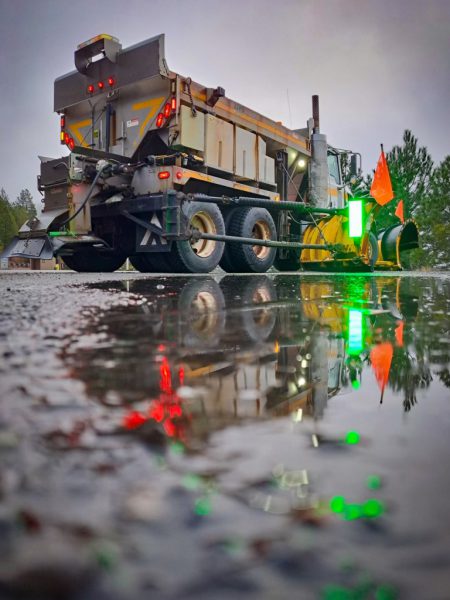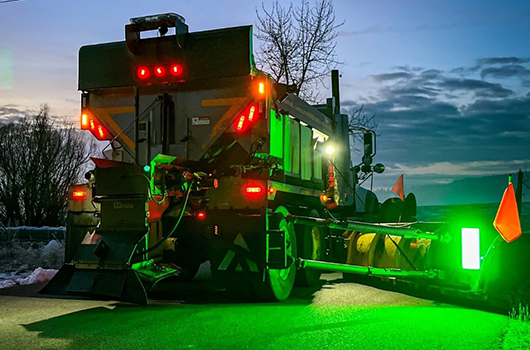A small number of snowplows in North Idaho are taking part in a preliminary testing program being used to assess the efficacy of increasing visibility on plows and reducing the number of strikes each winter.
These ultra-bright, LED lights are being put to the test not only to measure how effective they are, but also how well they stand up to the abuse of being attached to one of the hardest working members of a snow fighting team – the wing plow.
Science has proven that green and yellow are some of the most highly visible, detectable and recognizable colors on the spectrum to the human eye, both day and night, which is why green and amber have been selected as the colors for testing.
 Often, even when it’s not actively snowing, the plows on these trucks kick up tremendous clouds of snow and slush making it extremely difficult for drivers to see the low-profile wing plow while crews work. No matter how often drivers are warned to never pass a plow on the right, inevitably there are those who either miss the memo, or are too impatient to heed the warning and that is typically when those plow strikes occur.
Often, even when it’s not actively snowing, the plows on these trucks kick up tremendous clouds of snow and slush making it extremely difficult for drivers to see the low-profile wing plow while crews work. No matter how often drivers are warned to never pass a plow on the right, inevitably there are those who either miss the memo, or are too impatient to heed the warning and that is typically when those plow strikes occur.
The hope is that these bright lights will produce enough illumination to shine through the sprays of snow, slush and ice and be a visual warning to motorists that there is dangerous equipment on the road ahead.
Compared to the heavy financial hit suffered each time a plow is struck these lights are an incredibly inexpensive and effective way to improve safety, each ringing in at around $300 in total for the parts and labor required to install them.
On the flip side, while the circumstances of each plow strike are unique, it is estimated that it costs the Idaho Transportation Department roughly $10,000 per incident in parts and labor to repair equipment damaged in an incident. In addition to the financial hit, the larger impact is often having a truck out of service for extended periods of time meaning additional strain on mechanics to get them fixed, and on plow crews to work harder with fewer resources to keep the roads safe.
If these lights prove successful over the 2023-2024 winter, ITD will likely do a more comprehensive pilot program next year including more trucks across broader areas throughout the state.
Green lights have been successfully adopted several state transportation departments including Utah and Montana, and in several cities and counties in eastern Washington. They are also currently being considered by Washington, Wyoming, and Oregon state transportation departments. “Having uniformity between neighboring agencies is another big reason we are trying this out,” said Fleet Operations Manager Ryan Crabtree This uniformity enhances safety by ensuring driver experiences and expectations remain the same from place to place as they travel throughout the Pacific Northwest.

